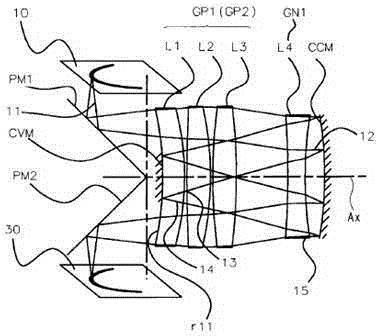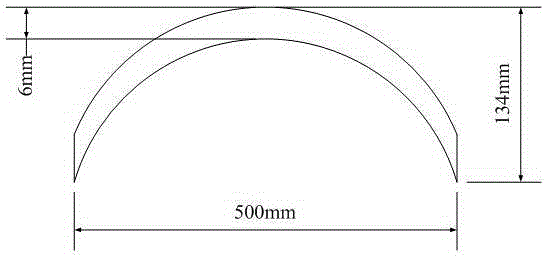Lithography Projection Objectives
A technology of lithography projection and objective lens, which is applied in the direction of microlithography exposure equipment, optics, optical components, etc., can solve the problems of increased difficulty in objective lens manufacturing, increased cost, low exposure efficiency, etc., achieve excellent exposure image quality, improve production rate, increase the effect of exposure illumination
- Summary
- Abstract
- Description
- Claims
- Application Information
AI Technical Summary
Problems solved by technology
Method used
Image
Examples
Embodiment 1
[0027] Projection objective lens optical system structure of the present invention such as figure 2 shown. After the mask surface 1 is irradiated by the illumination light, the light passing through the mask is reflected by the plane reflector 2 and then enters the spherical reflector 3. The plane reflector 2 makes the chief ray of each object point reflect at 90 degrees. The concave spherical reflector 3 has positive refractive power, so that the light falling on it can be partially converged and reflected, and the light reflected from the spherical reflector 3 enters the lens 4 and the lens 5 in turn, and the lens 4 and the lens 5 have negative power respectively. Refractive power and positive refractive power, the light rays of each object point form a pupil surface on the spherical mirror 6 after passing through the above-mentioned optical components. After the light is reflected by the spherical mirror with negative refractive power, it passes through lens 5, lens 4, an...
Embodiment 2
[0037] Embodiment 2 of the present invention is based on Embodiment 1. The spherical surfaces of the two lenses 4 and 5 are changed to aspheric surfaces to correct more different types of aberrations and obtain excellent image quality patterns in the exposure area.
[0038] The structural data of this embodiment is as follows:
[0039]
[0040]
[0041] The parameters of each aspheric surface are as follows:
[0042] Surface
[0043] In this embodiment the wave aberration RMS value is as Figure 5 As shown, the maximum is 0.0111λ, and λ takes the wavelength of the h line (404.65nm).
PUM
| Property | Measurement | Unit |
|---|---|---|
| diameter | aaaaa | aaaaa |
Abstract
Description
Claims
Application Information
 Login to View More
Login to View More - R&D
- Intellectual Property
- Life Sciences
- Materials
- Tech Scout
- Unparalleled Data Quality
- Higher Quality Content
- 60% Fewer Hallucinations
Browse by: Latest US Patents, China's latest patents, Technical Efficacy Thesaurus, Application Domain, Technology Topic, Popular Technical Reports.
© 2025 PatSnap. All rights reserved.Legal|Privacy policy|Modern Slavery Act Transparency Statement|Sitemap|About US| Contact US: help@patsnap.com



